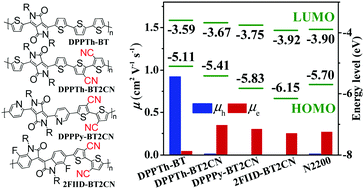n-Type conjugated polymers based on 3,3′-dicyano-2,2′-bithiophene: synthesis and semiconducting properties†
Abstract
Three new alternating copolymers containing 3,3′-dicyano-2,2′-bithiophene (BT2CN), i.e., DPPTh-BT2CN, DPPPy-BT2CN and 2FIID-BT2CN based on diketopyrrolopyrrole (DPP) and isoindigo (IID) derivatives, were synthesized. The properties of these three polymers were compared with those of the reference polymer without a cyano (CN) group, DPPTh-BT. The introduction of CN groups dramatically lowered both the highest occupied molecular orbital (HOMO) and the lowest unoccupied molecular orbital (LUMO) energy levels of the polymers. DPPTh-BT2CN exhibited HOMO and LUMO energy levels of −5.41 and −3.67 eV, respectively, which are much lower than those of the analogue polymer DPPTh-BT comprising a biothiophene (BT) segment. DPPPy-BT2CN and 2FIID-BT2CN showed even lower HOMO and LUMO levels, which are −5.83 and −3.75 eV for DPPPy-BT2CN and −6.15 and −3.92 eV for 2FIID-BT2CN. Organic thin-film transistors (OTFTs) were fabricated to evaluate the semiconducting properties of the polymers. DPPTh-BT2CN-based OTFTs exhibited electron-dominant transport characteristics, similar to the devices based on the benchmark n-type conjugated polymer N2200. By contrast, DPPPy-BT2CN and 2FIID-BT2CN-based devices displayed pure n-channel characteristics due to their lower HOMO and LUMO levels. All three polymers displayed an electron mobility (μe) of ca. 0.3 cm2 V−1 s−1, which is comparable to that of N2200 when the same device structure and measurement conditions were adopted.



 Please wait while we load your content...
Please wait while we load your content...